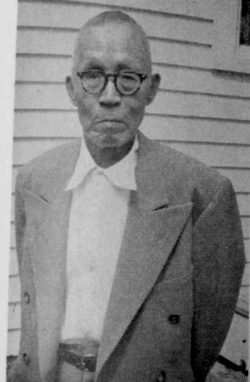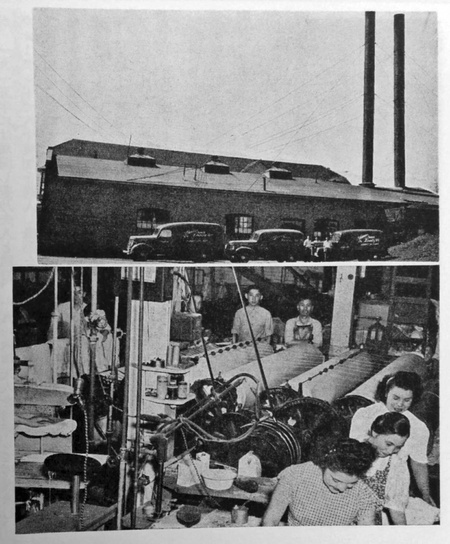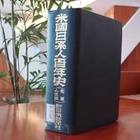When people in Japan hear the state of Wyoming, they probably conjure up images of western movies and cowboys. There used to be a TV drama called "Laramie," which was also broadcast in Japan and gained popularity. Laramie is located in the southeastern corner of Wyoming.
The "Centennial History" devotes five pages, including a directory, to this state, located in the northwestern United States, and its Japanese and Japanese-American people.
Wyoming borders Colorado and Utah to the south, Montana to the north, South Dakota and Nebraska to the east, and Idaho to the west. Most of Wyoming is mountainous. The famous Yellowstone National Park is located in the northwest of the state.
The book begins with an overview and then goes on to provide specific records of the activities that the Japanese began in this inland mountain state.
For example, he writes about Cheyenne, a city in Laramie County in the southeastern corner of the state:
"It is a key railroad hub and is famous as the center of the livestock industry in the northern United States, so it has been a popular city in American western cowboy movies."
The first Japanese people arrived in Wyoming around 1903 or 1904, and their first forays were with railroad construction.
"Around 1905, there were only two Japanese married couples. It was just like a Wild West at the time, with the town wide open, gambling dens, brothels, and bars lined up, and it was filled with a frontier atmosphere."
There were three Western-style restaurants run by Japanese people, and an inn. However, it was only called an inn in name; it was just a place to eat and sleep, with people sleeping on mattresses laid out on the floor.
Regarding the treatment of Japanese people around them, there was no anti-Japanese sentiment or violence, but there were two or three upscale Western restaurants that did not allow Japanese customers, and at the Princess Theatre, Japanese and Chinese people were allowed upstairs and were subjected to discriminatory treatment.
Of course, it is easy to imagine that the authors of the century-long history would have interviewed people in the area who knew about the past, and would have been able to obtain many amazing and valuable testimonies that would not be available today.
Let's summarize it again along the 100-year history:
In Wyoming, around 1900, mining was popular after cattle ranching, and most of the Japanese settlers were railroad and coal miners. At the time, the state's population was about 92,500. Of those, 393 were Japanese, but the number of such workers increased, and by 1910, their number had swelled to 1,503.
"Rock Springs was the first place where Japanese people came to Honshu, and they were established as early as 1898 under a contract with Gen Nishiyama. By 1905, when he became affiliated with the Nichibei Kingyosha, they had expanded their influence to include the Frontier and Superior areas of Sweetwater."
At that time, workers in coal mines and railroads were sent to the sites by what would be today's dispatch companies or bosses, who would make contracts with railroad companies and other companies and send workers to the sites in bulk. Nichibei Kin'yosha is thought to have been one such company. Around 1910, there were seven coal mines where Japanese people worked, and the workers were said to have belonged to white labor unions.
Regarding railway workers:
"Meanwhile, employment of Japanese on the railroad in Wyoming was several years behind that in Montana, Idaho, and Utah. In 1903, the Wakimoto and Nishimura Group teamed up with the Morita Group, signed a contract with the UP Railroad Company, and brought over 200 Japanese to Epanston on the Utah border..."
Many Japanese people also immigrated from Hawaii and Mexico, but the number decreased after the "ban on immigration" was issued in 1907, and many people switched from railroad work to work on plantations, canneries, or agriculture. This paved the way for Japanese people to become farmers in the state.
The number of railway labor companies decreased, but from around 1910 Japanese people were promoted to foremen and they were now in a position to employ Italians and Greeks.
In the north and northeast, although there were a few small farmers, "large-scale farming" was practiced. "Crop cultivation was started around 1919 by the pioneer brothers Ujifusa Mori from Woburn."
The book begins by introducing the Japanese and Japanese-Americans in Cheyenne, but also goes on to tell the story of their whereabouts, dividing them into Rock Springs, Kemmerer, Sheridan, Worland, and Heart Mountain settlements.
Rock Springs was a mining and railroad town, and by 1918 it was already deserted, but there were photo studios, grocery stores, barber shops, restaurants, billiards, hotels, and other businesses run by Japanese people, and there was also a "gambling and ugly den." A Buddhist church was preaching there from Salt Lake City, Utah.
On August 14, 1923, there was a mine explosion, killing over 100 people, including a dozen Japanese. The following year, there was another explosion, killing several Japanese. In the same mining town of Kyyamah, the gravestones of the dozen or so victims were erected on the outskirts of the town.
"Some of the gravestones are next to those of parents and children who were scattered in remote areas of the immigrant community, and along with the 100 or so other graves of their ancestors, they arouse sentimental feelings among the Japanese residents who clean them and offer flowers at the annual memorial service."
The Heart Mountain Internment Camp was one of the internment camps for Japanese Americans established in the United States after the start of the Pacific War.
"The internment of over 10,000 people over a period of more than three years was the largest event in the history of Japanese Americans in Wyoming. The sudden relocation of a huge number of Japanese Americans caused an unexpected war boom in the neighboring city of Powell, but the local Japanese people there, as well as in the Worland area, spent their days extremely busy providing comfort and various forms of support."
At that time, the person who instructed the internment camps on how to grow vegetables was Morikazu Ujifusa, a local farmer from Wyoming. Because Wyoming is inland, Japanese and Japanese-Americans living there were forced to leave and were not interned. Ujifusa provided instruction without pay, and worked to promote friendship between the United States and Japan.
Ujifusa's career is also unique. Born in Okayama Prefecture in 1881, he traveled to Hawaii in 1904 and then to San Francisco. He then worked on the railroad between Wyoming and Nebraska, but began farming in his third year. He successfully cultivated potatoes and beans in a remote village.
Making use of his experience as a cattle breeder in Japan, he started a grazing business in the wilderness with one cow and increased it to 570. In 1917, he also became the first Japanese to hire cowboys.
"In 1945, oil began flowing from his farm, bringing in huge royalties. As a benefactor of Wyoming's industrial sector, he was highly respected among both Japanese and whites, and dedicated himself to society as a local elder statesman."
In Kiyamar, brothers Ichitaro and Yoshimatsu Miyake, originally from Fukuoka Prefecture, established the Kiyamar Union Laundry in 1941. When war broke out between Japan and the United States, the laundry was boycotted by white customers and fell into a difficult position, but it continued to operate throughout the war.
A large boiler was installed in the laundry, "which is used to provide steam heat to the city of Kiyamah, and is loved by the citizens for its whistle that sounds the time."
According to the census, the Japanese population in Wyoming peaked at 1,194 in 1920 before the war, but fell to 450 in 1950 and 514 by 1960.
(Note: I have used the original text as much as possible, but have made some edits. In addition, I have based the names of places on the way they are written in the "Centenary History.")
* Next time, we will cover " Japanese Americans in Montana ."
© 2015 Ryusuke Kawai








